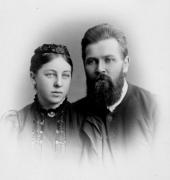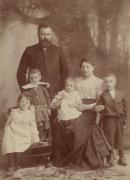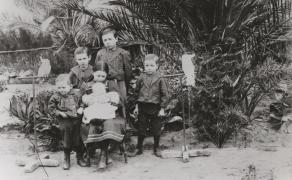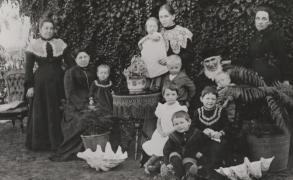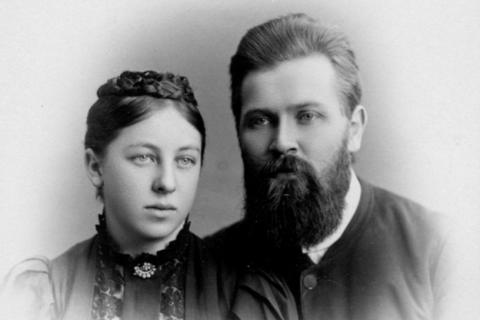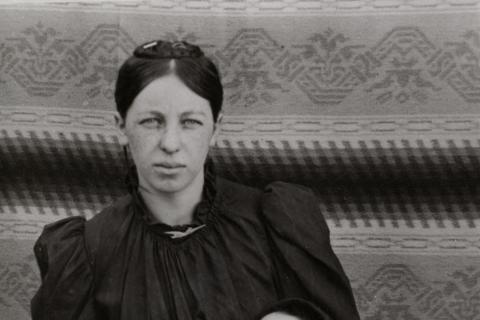Carl Strehlow arrived on 12 October 1894, to a mission in disrepair, with building with collapsed roofs, a lack of stores and what he considered were poorly controlled white lay staff. After completing an audit of supplies and resources, he dismissed some of the lay staff, began holding services and set about learning the traditional Arrarnta (Aranda as it was called then) language. By the end of 1894 there were approximately 66 Aboriginal people including 18 Christian adults, eight Christian children, and 40 non-Christian Aboriginals at the mission. By 1896 this number had grown to 100.
Strehlow was joined by his co-missionary Pastor Bogner and his wife and son in May 1895. Bogner took over management of the station including the cattle and assisted with the missionary work. Work began in earnest on rebuilding the mission buildings. In early 1896 two builders were hired who left a legacy in terms of the current buildings at Hermannsburg (Mr. Hart and Mr. Haemmerling, the latter was also a stonemason). Strehlow insisted that the buildings use local materials: stone from the Finke River was used, and lime was produced at the mission in a kiln.
The school was opened 7th June 1896, it was also untilised as a temporary church. The Strehlow's House was built between October 1896 and July 1897. Work on the church began in July 1897 but was not completed until Christmas that year. The dedication of the church was a bi-lingual ceremony with the dedication by Bogner in English and followed by Strehlow in Arrarnta. The church which you can see today at Hermannsburg hosted 186 baptisms (172 Aboriginal people and 14 European children) over its life.
Challenges and conflict
Despite the successes, life was still challenging for those on the mission. Impacts from the outside world still buffeted the Arrarnta people and the missionaries. Unchecked exploitation by Europeans in the region led to outbreaks of syphilis and continuing genocide in Central Australia meant that Aboriginal people lived in constant fear of death outside the mission confines and were increasingly cut off from traditional food sources. Numbers at the mission swelled as more Arrarnta people sought refuge and food. Cyclical droughts were an ongoing problem affecting cattle, crops and human health. In 1899 an outbreak of measles caused the death of 32 Arrarnta people. In 1900 whooping cough affected the people at the mission and four people died. Missionary Bogner left Hermannsburg around this time due to his wife’s poor health and he was later replaced in 1901 by Mr. N Wettengel and his wife and two children. Over the next few years, the relationship between Strehlow and Wettengel deteriorated and Wettengel eventually left to return to Germany.
Drought was an ongoing strain on the mission; 1903 was a desperate year with one of the worst droughts experienced so far. There was no feed for the cattle and horses, no vegetable could be grown. A similar lack of native hunting resources saw more Arrarnta driven to the mission in search of food adding pressure to their limited resources. This drought continued through to 1906 until rains finally came around Christmas that year.
Although so far away the effects of the war in Europe were felt at Hermannsburg
During World War I the mission came under increased public pressure and scrutiny as a ‘German Institution’. Neighbouring landowners who stood to gain from the closure of the mission joined in allegations that the mission was teaching Arrarnta people to speak German and other such claims. While these did not achieve their desired result of cancelling the missions lease, the government did stop paying the annual subsidy to the mission which was a harsh blow financially.
In 1919 Strehlow celebrated the 25th Anniversary of his arrival at Hermannsburg on 12 October. In that time:
- 176 Arrarnta had been baptised (46 Adults and 130 children);
- 18 had been confirmed;
- 24 married;
- 53 Arrarnta Christians had died and been buried; sadly 45 of these had been children;
- Strehlow assisted by Arrarnta man, Moses, completed the manuscript of the translation of the New Testament into the Aranda language;
- In response to Baldwin Spencer’s book on the Arrarnta he wrote Die Arana- und Loritja-Stämme in Zentral-Australien published by Städtisches Völker- Museum Frankfurt;
- 264-page Arrarnta Service Book, 1904, published Tanunda SA;
- 30-page school primer in Arrarnta later printed in 1928;
- Strehlow translated the entire new testament into Arrarnta with The Gospel according to St Luke being published by the British and foreign Bible Society in 1925 and all four gospels published by the society.
In September 1922, Strehlow became gravely ill suffering from ‘dropsy, asthma and pleurisy’ and was too weak to be moved. While the mission authorities scrambled to try and arrange for a car to transport Strehlow south, Heinrich took matters into his own hands loading Strehlow and his wife and young son onto a covered buggy and heading out. Sadly, Strehlow only made it as far south as Horseshoe Bend where he died on 20 October 1922 and was buried the next day.
Media
